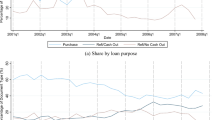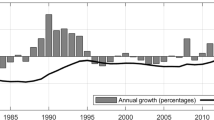Abstract
In this paper, we deduce the default and prepayment characteristics of mortgages by examining the actual behaviors of a large set of conforming fixed rate mortgages tracked over time. Employing reduced form pricing techniques, we are then able to fully value such mortgages, and so determine the cost as well as the probability of default for any particular mortgage. The analysis reveals the levels of foreclosures that can be expected when loans are leveraged at the high loan–to–value ratios characteristic of recent years.




Similar content being viewed by others
Notes
The structural approach to credit risk goes back at least to Merton (1974). For application to mortgages, see, for instance, Titman and Torous (1989) or Kau et al. (1992). For the reduced form approach to credit risk, see the treatment in the 3rd edition of Duffie (2001) and the monographs by Bielecki and Rutkowski (2002) or Duffie and Singleton (2003). Seminal papers in continuous time include Madan and Unal (1998), Lando (1997, 1998), and Duffie and Singleton (1999).
See, for instance, Deng et al. (2000) and the cites therein.
The mortgage histories were provided by Bank of America (BoA).
Negative points represent a calculation by BoA to cover cases where, rather than pay closing costs, the borrower accepts a higher contract rate.
The term t(i) means the calendar time of the ith payment date.
Because we are assuming that termination only occurs at payment dates, the actual proportional hazard procedure is a more recently developed one, due to Prentice and Kalbfleisch (2003). It turns out that the estimation of the covariates is done in exactly the same as is the Cox partial likelihood procedure, though estimation of covariances changes. While the covariate coefficients are estimated prior to the other parameters of the default process, there is no inconsistency since, as with the Cox partial likelihood procedure, no knowledge of the baseline is required to estimate these coefficients.
Freddie Mac’s Conventional Mortgage Home Price Index (CMHPI) is available at www.freddiemac.com/finance/cmhpi. The logic of detrending is that when the effect of original loan size on subsequent default is compared across loans with different times of origination it ought to be real size of the loan at its time of origination and not its nominal size that is of consequence to the comparison.
It was, a priori, judged impractical to stratify any finer than by quarters.
The method we use is the basic SIR particle filter of Gordon et al. (1993), with stratified resampling from a “smoothed” version of the particles’ empirical distribution function, as discussed in Pitt (2002). See Doucet et al. (2000) for a collection of articles describing particle filter methods in detail. Pitt establishes that the particle filter method has the desired convergence property, when the number of particles grows large.
See, for instance, Wang (1986) for a modern form of the appropriate Poisson approximation result. Note that the interaction of default and prepayment is second-order small, and so disappears in the limit.
In the estimation of the termination processes, we must replace the unknown \(\boldsymbol{\beta}\) with the \(\hat{\boldsymbol{\beta}}\) estimated in the previous stage, but this has no effect on consistency, and given the large number of individual houses, little effect on standard errors, which remain asymptotically correct.
See Pitt (2002).
The maximum likelihood method is the obvious estimation technique to use throughout the paper, since typical reduced-form analysis already imposes strong assumptions on the model’s distributional properties.
As indicated above, α d in Table 6 is a multiplicative factor unnormalizing the chi-square p.d.f. The \(\uprho\) in Table 6 serves as the single parameter of a \(\chi^2(2\uprho)\) p.d.f. The notation α 0, α 1, α 2, etc., in Table 7 always indicates the coefficients of a polynomial, in the obvious sense.
We performed heteroscedasticity-robust Wald tests for the presence of pth-order autoregressive lags in each series’ unstandardized residuals, obtained from the one-step ahead predictions in maturity time. We included lagged dependent variables to the same order (six and twelve) as the number of lagged residuals being tested for. The larger serial correlation at twelve lags may partly reflect the presence of unaccounted for seasonality factors. We tentatively included seasonality originally, but since it appeared insignificant, we eliminated it, considering it inconvenient that our contract rate predictions should differ between two identical contracts with the same initial state variables, but where one originated in, say, June and one in September.
To help assure the location a global minimum, the optimization routine was accompanied by a simulated annealing procedure.
The data on mortgage rates are obtained from the FRED II database, maintained by the Federal Reserve Bank of St. Louis. The pass-through rates are published monthly in the Federal Reserve Bulletin.
The RMSE we obtain over the entire observation period is similar to the 1.6% RMSE obtained in Titman and Torous (1989), who were, however, working with commercial mortgages, which feature the possibility of default, but not prepayment.
While the loss rate involves market expectations and need not be real, it nonetheless appears quite stable and corresponds well with our priors concerning average real loss rates.
The mortgage randomly picked for the example originated in March, 2001, and had an original loan balance of $147,250, with 0.8 points, an 80% LTV, and a contract rate of 7.25%. Parameters obtained from the July 2001 sample were used in all of following pricing exercises.
Total prepayment lowers the value of the loan by such a small net amount because prepayments not made for the explicit purpose of refinancing can often be to the lender’s advantage. This never occurs with default, which in any reasonable scenario always proves disadvantageous for the lender. This same sort of “non-financial” prepayment explains why a loan permitting both prepayment and default can be more valuable to the lender than one permitting only default; early prepayment is precluding the more costly default that would otherwise be expected to occur later on. This could never happen in a strict options-pricing model, where the lender would only prepay when he expects it to increase the costs to the lender.
Note that the contract rate is endogenized according to (10) so as to be appropriate for each separate loan.
Memory of the systematic steep declines of earlier periods, or anticipation of the declines to come, may help explain why the multiplicative factor on default remains noticeable greater than 1.
References
Amato, J. D., & Remolona, E. M. (2005). The pricing of unexpected credit losses. Working paper.
Bélanger, A., Shreve, S. E., & Wong, D. (2003). A general framework for pricing credit risk. Working paper.
Berndt, A., Douglas, R., Duffie, D., Ferguson, M., & Schranz, D. (2005). Measuring default risk premia from default swap rates and EDFs. Working paper.
Bielecki, T. R., & Rutkowski, M. (2002). Credit risk: Modelling, valuation and hedging. Springer.
Bliss, R. R. (1997). Testing term structure estimation methods. Advances in Futures and Options Research, 9, 191–231.
Chen, R.-R., & Scott, L. (2003). Multi-factor Cox–Ingersoll–Ross models of the term structure: Estimates and tests from a Kalman filter model. Journal of Real Estate Finance and Economics, 27, 143–172.
Conley, T. G. (1999). GMM estimation with cross sectional depndence. Journal of Econometrics, 91, 1–45.
Deng, Y., Quigley, J. M., & Van Order, R. (2000). Mortgage termination, heterogeneity and the exercise of mortgage options. Econometrica, 68, 275–307.
Doucet, A., de Freitas, J. F., & Gordon, N. (2000). Sequential Monte Carlo methods in practice. Cambridge University Press.
Driessen, J. (2002). Is default event risk priced in corporate bonds. Working paper, University of Amsterdam.
Duffee, G. (1999). Estimating the price of default risk. Review of Financial Studies, 12, 197–226.
Duffie, D. (1998a). Defaultable term structure models with fractional recovery of par. Working paper.
Duffie, D. (1998b). First-to-default valuation. Working paper, Stanford University.
Duffie, D. (2001). Dynamic asset pricing theory (3rd ed.). Princeton University Press.
Duffie, D., & Singleton, K. J. (1999). Modelling term structures of defaultable bonds. Review of Financial Studies, 12, 687–720.
Duffie, D., & Singleton, K. J. (2003). Credit risk. Princeton University Press.
Giesecke, K. (2003). Credit risk modelling and valuation: An introduction. Working paper, Cornell University.
Gordon, N. J., Salmond, D. J., & Smith, A. F. M. (1993). A novel approach to non-linear and non-Gaussian Bayesian state estimation. IEE-Proceedings Part F, 140, 107–133.
Jacod, J., & Shiryaev, A. N. (1987). Limit theorems for stochastic processes. Springer-Verlag.
Jarrow, R. A., Lando, D., & Yu, F. (2003). Default risk and diversification: Theory and applications. Working paper, Cornell University.
Jegadeesh, N., & Ju, X. (2000). A non-parametric prepayment model and valuation of mortgage-backed securities. Journal of Fixed Income, 10(1), 50–67.
Kau, J. B., Keenan, D. C., Muller, W. J. & Epperson, J. F. (1992). A generalized valuation model for fixed-rate residential mortgages. Journal of Money, Credit and Banking, 24, 279–299.
Lando, D. (1997). Modelling bonds and derivatives with default risk. In Mathematics of derivative securities (pp. 369–393). Cambridge University Press.
Lando, D. (1998). On Cox processes and credit risky securities. Review of Derivatives Research, 2, 99–120.
Madan, D., & Unal, H. (1998). Pricing the risk of default. Review of Derivatives Research, 2, 121–160.
Merton, R. C. (1974). On the pricing of corporate debt: The Risk structure of interest rates. The Journal of Finance, 29, 449–470.
Merton, R. C. (1976). Option pricing when underlying stock returns are discontinuous. Journal of Financial Economics, 3, 125–144.
Pitt, M. K. (2002). Smooth particle filters for likelihood evaluation and maximization. Working paper.
Prentice, R. L., & Kalbfleisch, J. D. (2003). Mixed discrete and continuous Cox regression model. Lifetime Data Analysis, 9, 195–210.
Ridder, G., & Tunali, I. (1999). Stratified partial likelihood estimation. Journal of Econometrics, 92, 193–232.
Saita, L. (2006). The puzzling price of corporate default risk. Working paper.
Schönbucher, P. J. (2003). Credit derivatives pricing models: Model, pricing and implementation. Wiley.
Schwartz, E. S., & Torous, W. N. (1989). Prepayment and the valuation of mortgage-backed securities. The Journal of Finance, 44, 375–392.
Titman, S., & Torous, W. (1989). Valuing commercial mortgages: An empirical investigation of the contingent-claims approach to pricing risky debt. The Journal of Finance, 44, 345–373.
Wang, Y. H. (1986). Coupling methods in approximations. Canadian Journal of Statistics, 14, 69–74.
Wooldridge, J. M. (2002). Econometric analysis of cross section and panel data. MIT Press.
Acknowledgements
We thank Robert Bliss and Garland Durham for graciously providing computer code. We also wish to thank Walter J. Muller III.




